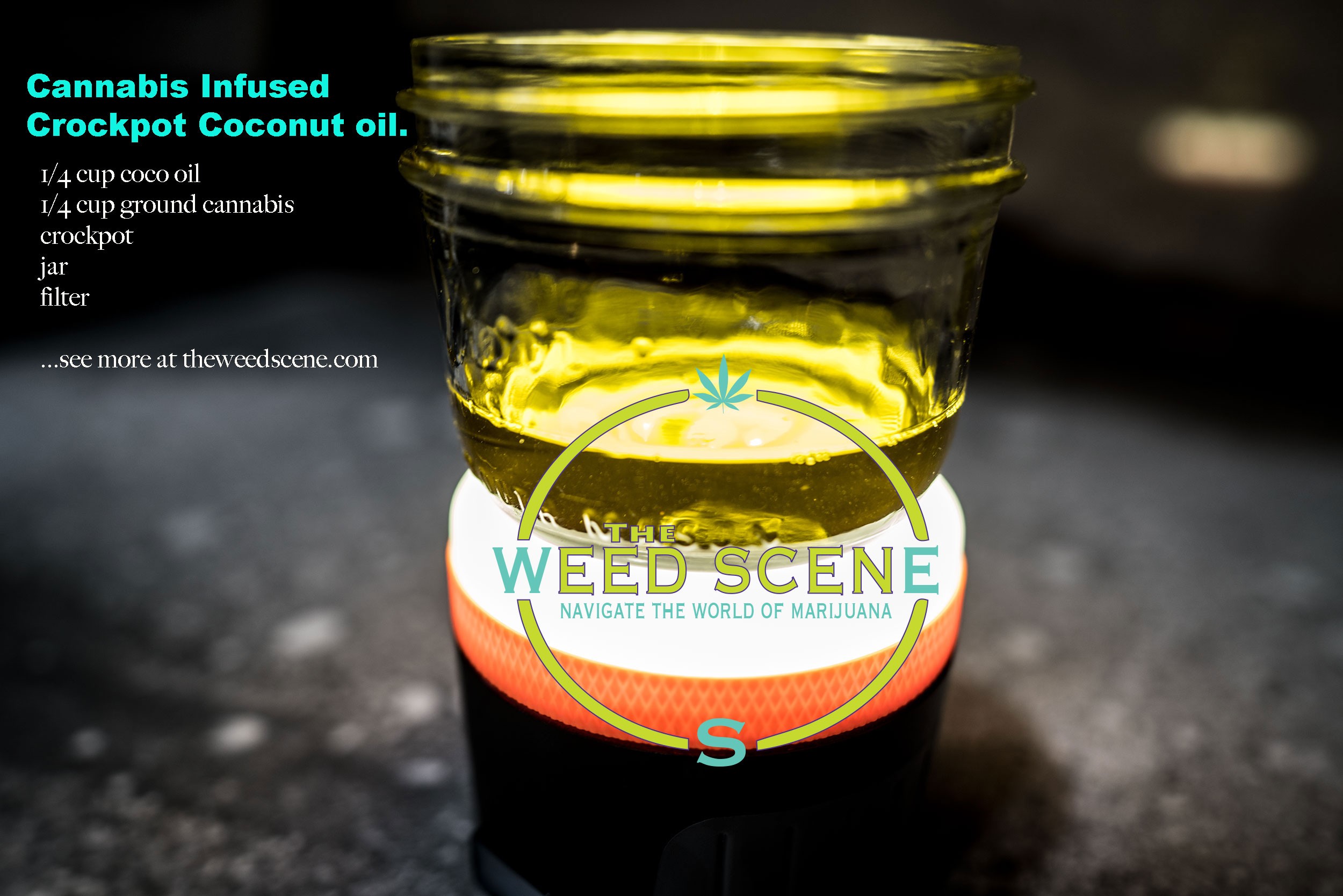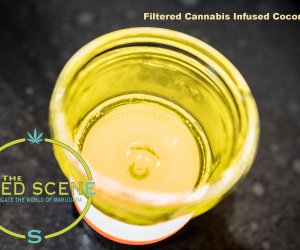Cannabis infused coconut oil should be one of the first recipes every cannabis connoisseur learns, next to cannabutter, as they are the most common staples in any recipe using cannabis. This step-by-step guide will show you exactly how to make the best cannabis coconut oil, using your crockpot! This recipe is dairy-free & plant based, and can be used for many things other than cooking, like self-care products.
Plant Based & Dairy-Free
Making cannabutter or cannabis oil is not as difficult as you may think. All you need is a few simple items and this easy-to-follow step-by-step recipe.
Benefits to using cannabis oil
Coconut oil is known for its many benefits, from cooking to skin care, adding cannabis to it just makes it that much better. You can still use it as you normally would, just with the added “relaxation” benefit you get from it.

Step-by-step recipe for making vegan, dairy-free Crockpot Cannabis Oil.
Whether you’re making cannabutter or cannabis oil, there are a few things you’ll need to make it – cannabis, coconut oil, a crockpot (a pot and lid on stove also works if you don’t have a crockpot), water, a filter like a cheesecloth, stocking or paper filter, and a jar with a lid.
The process to making cannabis oil is pretty simple – first you decarboxylate the cannabis, then you use heat and fat to extract the thc out of it, leaving it infused in the oil.
Once it’s finished, you’ll be left with a cannabis-infused or thc-infused coconut oil, known as canna oil. This oil can be used to make many different marijuana edibles recipes, as well, it can also be used for self-care, like a lotion or hair product.
For maximum potency, decarboxylate the cannabis before adding to the oil.
Cannabis decarboxylation is very simple to do and it also makes a huge difference in the potency of the finished canna oil. You simply Preheat oven to 240°F (160°C) exactly (use an oven thermometer to be sure).
Grind cannabis buds into a powder using either your hands or a grinder. Spread cannabis in a thin layer on a clean cookie sheet or any oven-safe dish. Put in the oven until the first of smoke or 40mins, whichever is first. Remove and set aside.

Health benefits of using coconut oil
If you’re like me, someone who likes to cook with cannabis – but wants to do it healthy, cannabis infused coconut oil is the perfect dairy-free, vegan, vegetarian, plant-based, and allergen-friendly substitute to cannabutter. The best alternative for anyone following a specialty diet or for anyone who just wants a substitute to every day butter.
Different ways to make cannabis oil
There are many ways to make cannabis-infused oil, all of which doing the same thing – this recipe is by far the simplest and most effective way to make cannabis coconut oil.
The best temperature to cook cannabis at
Temperature control is very important when cooking with cannabis. Cooking too hot could easily burn the cannabis, causing damage to individual terpenes, thus making it useless. Heat is most important during carboxylation as that’s when the acids in the cannabis are turned into active cannabinoids our bodies can use. Always try keeping temps below 300°F (148° C) as that’s when the cannabis is most likely to get burned.
What’s the best strain of weed to use to make cannabis oil
What strain you use to make your canna oil with is a very important thing to think about prior to making the cannabis oil. Simple way to remember – any sativa-based strain will be good for daytime use as it’s the “stay awake” strain. Any type of indica-based strain will be good for nighttime use as it’s the “sleepy” kind.
Different equipment used to make cannabis coconut oil
You can use this recipe to make canna oil in whatever kitchen equipment you have available, whether it be a slow cooker, pot with lid or instapot. No matter which you choose, the main thing to remember is keeping the heat at the proper temperature.
PrintCrockpot Cannabis Coconut Oil
Simple step-by-step recipe for making the best cannabis-infused, vegan, dairy-free, plant-based coconut oil using a crockpot (can also be made using other equipment) in the comfort of your own home that you can later use to make many different cannabis-infused edibles.
- Yield: 5–8 TBSP 1x
Ingredients
- 1/4 cup coconut oil
- 1/4 cup ground cannabis flower
- water
- crockpot
- 2 jars with lids
- filter (stocking, cheesecloth, paper filter..etc)
Instructions
- put the coconut oil into the jar
- put the decarboxylated cannabis in the jar with the oil and put the lid on (does not have to be super tight), leaving at least a half inch of space between the cannabis and top of jar.
- fill crockpot with enough water to cover most of the jar
- heat crockpot on high until water reaches 185°F
- place the jar into the preheated water and place lid on crockpot.
- cook for 4 hours
- carefully remove the jar and set aside to cool
- while its cooling, place a filter inside a clean jar (I like to use stockings as they fit snug over the jar)
- once oil has been cooled, remove lid and pour into stocking, squeezing out as much of the oil as possible.
- If there are any pieces of plant matter in the oil, you can filter again to remove them
- let cool, place lid on and store in a cool place
Keywords: canna oil, cannabutter, weed oil, thc oil, tincture











I think this is among the most vital info for me. And i am glad reading your article. But wanna remark on few general things, The website style is ideal, the articles is really great : D. Good job, cheers
This article is a breath of fresh air! The author’s unique perspective and perceptive analysis have made this a truly captivating read. I’m grateful for the effort she has put into producing such an informative and thought-provoking piece. Thank you, author, for providing your expertise and igniting meaningful discussions through your outstanding writing!
Great paintings! That is the type of information that are supposed to be shared around the net. Shame on the search engines for now not positioning this put up upper! Come on over and visit my site . Thank you =)
I have realized that over the course of developing a relationship with real estate managers, you’ll be able to get them to understand that, in most real estate exchange, a percentage is paid. All things considered, FSBO sellers tend not to “save” the commission. Rather, they try to earn the commission by simply doing an agent’s job. In doing so, they spend their money plus time to carry out, as best they are able to, the jobs of an agent. Those obligations include disclosing the home via marketing, representing the home to willing buyers, developing a sense of buyer emergency in order to prompt an offer, arranging home inspections, handling qualification assessments with the lender, supervising repairs, and assisting the closing.
I am no longer certain the place you’re getting your information, however great topic. I needs to spend a while studying much more or understanding more. Thank you for excellent information I was in search of this information for my mission.